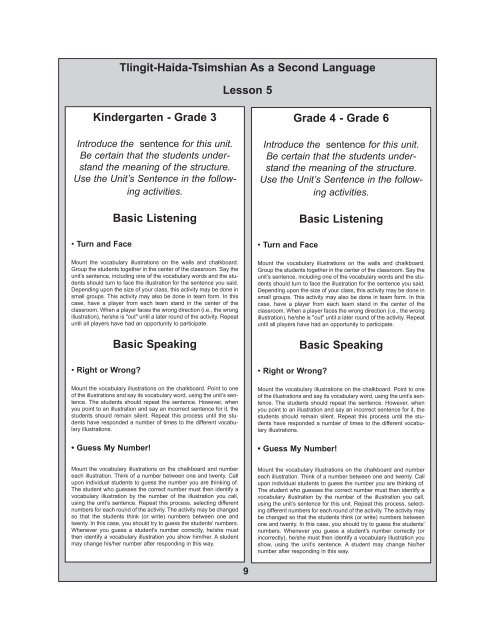Download - Sealaska Heritage Institute
Download - Sealaska Heritage Institute
Download - Sealaska Heritage Institute
You also want an ePaper? Increase the reach of your titles
YUMPU automatically turns print PDFs into web optimized ePapers that Google loves.
Tlingit-Haida-Tsimshian As a Second Language<br />
Lesson 5<br />
Kindergarten - Grade 3<br />
Introduce the sentence for this unit.<br />
Be certain that the students understand<br />
the meaning of the structure.<br />
Use the Unit’s Sentence in the following<br />
activities.<br />
• Turn and Face<br />
Basic Listening<br />
Mount the vocabulary illustrations on the walls and chalkboard.<br />
Group the stu dents together in the center of the classroom. Say the<br />
unit’s sentence, including one of the vo cabulary words and the students<br />
should turn to face the illustration for the sentence you said.<br />
Depending upon the size of your class, this ac tivity may be done in<br />
small groups. This activity may also be done in team form. In this<br />
case, have a player from each team stand in the center of the<br />
classroom. When a player faces the wrong di rection (i.e., the wrong<br />
il lustration), he/she is "out" until a later round of the ac tivity. Repeat<br />
until all players have had an opportunity to participate.<br />
• Right or Wrong<br />
Basic Speaking<br />
Mount the vocabulary illustrations on the chalkboard. Point to one<br />
of the illustra tions and say its vocabulary word, using the unit’s sentence.<br />
The students should repeat the sentence. However, when<br />
you point to an illustration and say an incorrect sentence for it, the<br />
students should remain silent. Repeat this process until the stu -<br />
dents have re sponded a number of times to the dif ferent vocabulary<br />
illustrations.<br />
• Guess My Number!<br />
Grade 4 - Grade 6<br />
Introduce the sentence for this unit.<br />
Be certain that the students understand<br />
the meaning of the structure.<br />
Use the Unit’s Sentence in the following<br />
activities.<br />
• Turn and Face<br />
Basic Listening<br />
Mount the vocabulary illustrations on the walls and chalkboard.<br />
Group the stu dents together in the center of the classroom. Say the<br />
unit’s sentence, including one of the vo cabulary words and the students<br />
should turn to face the illustration for the sentence you said.<br />
Depending upon the size of your class, this ac tivity may be done in<br />
small groups. This activity may also be done in team form. In this<br />
case, have a player from each team stand in the center of the<br />
classroom. When a player faces the wrong di rection (i.e., the wrong<br />
il lustration), he/she is "out" until a later round of the ac tivity. Repeat<br />
until all players have had an opportunity to participate.<br />
• Right or Wrong<br />
Basic Speaking<br />
Mount the vocabulary illustrations on the chalkboard. Point to one<br />
of the illustra tions and say its vocabulary word, using the unit’s sentence.<br />
The students should repeat the sentence. However, when<br />
you point to an illustration and say an incorrect sentence for it, the<br />
students should remain silent. Repeat this process until the stu -<br />
dents have re sponded a number of times to the dif ferent vocabulary<br />
illustrations.<br />
• Guess My Number!<br />
Mount the vocabulary illustrations on the chalkboard and num ber<br />
each il lustration. Think of a number between one and twenty. Call<br />
upon indi vidual students to guess the number you are thinking of.<br />
The stu dent who guesses the correct number must then identify a<br />
vocabulary illustration by the num ber of the illustration you call,<br />
using the unit’s sentence. Repeat this pro cess, selecting different<br />
num bers for each round of the activity. The ac tivity may be changed<br />
so that the students think (or write) numbers between one and<br />
twenty. In this case, you should try to guess the stu dents' numbers.<br />
Whenever you guess a student's number correctly, he/she must<br />
then identify a vocab ulary illustration you show him/her. A student<br />
may change his/her number after responding in this way.<br />
Mount the vocabulary illustrations on the chalkboard and num ber<br />
each il lustration. Think of a number between one and twenty. Call<br />
upon indi vidual students to guess the number you are thinking of.<br />
The stu dent who guesses the correct number must then identify a<br />
vocabulary illustration by the num ber of the illustration you call,<br />
using the unit’s sentence for this unit. Repeat this pro cess, selecting<br />
different num bers for each round of the activity. The ac tivity may<br />
be changed so that the students think (or write) numbers between<br />
one and twenty. In this case, you should try to guess the stu dents'<br />
numbers. Whenever you guess a student's number correctly (or<br />
incorrectly), he/she must then identify a vocab ulary illustration you<br />
show, using the unit’s sentence. A student may change his/her<br />
number after responding in this way.<br />
9
















